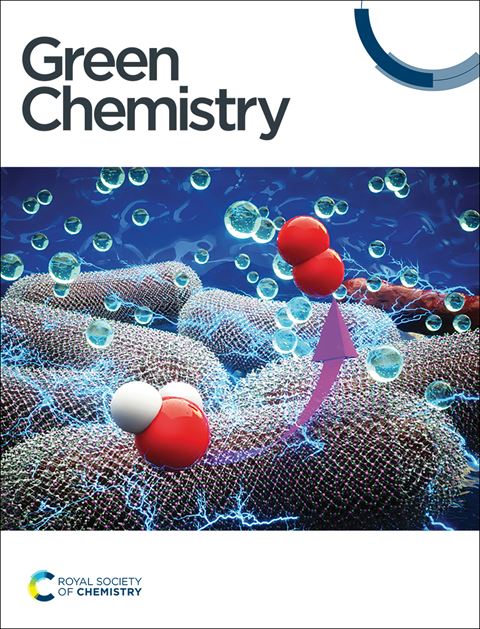可生物降解,完全生物基,热交联高吸水性聚合物,由柠檬酸和甘油†
IF 9.3
1区 化学
Q1 CHEMISTRY, MULTIDISCIPLINARY
引用次数: 0
摘要
本研究以多功能单体柠檬酸(CA)、柠檬酸钠(MSC)和甘油(GLY)为原料,经缩聚和热自交联制备了无交联剂、全生物基、可生物降解的高吸水性聚合物(sap)。本研究中使用的所有单体(CA、MSC、GLY)不仅是生物基的,而且是无毒的。它们都在一个分子中含有两个以上的亲水性基团,这在sap的生产中显示出很大的潜力。对合成的sap的结构、吸水性能和生物降解性进行了详细的研究。除去可溶性部分后,sap的凝胶含量约为60%,对去离子水的最大吸收能力为24±2 g g−1。此外,所制备的sap在含活性污泥的介质中具有良好的25°C生物降解性(28天后生物降解率为40%),因此是有潜力的环保材料,在我们的环境中有潜在的用途,不会像基于中和的聚丙烯酸和聚丙烯酰胺的商业不可生物降解sap那样产生持久性微塑料。因此,本文所述的生物基SAPs在包括卫生用品和农产品在内的可持续化学工业中具有广阔的应用前景,如控释肥料涂层和土壤改良剂。本文章由计算机程序翻译,如有差异,请以英文原文为准。

Bio-degradable, fully bio-based, thermally cross-linked superabsorbent polymers from citric acid and glycerol†
In this study, cross-linker free, fully bio-based, biodegradable superabsorbent polymers (SAPs) were synthesized from the multi-functional monomers citric acid (CA), monosodium citrate (MSC) and glycerol (GLY) by polycondensation and subsequent thermal self-cross-linking. All monomers (CA, MSC, GLY) used in this study were not only bio-based but also non-toxic. All of them contain more than two hydrophilic groups in one molecule, which shows great potential to be used in the production of SAPs. The structure, water absorbance capacity and biodegradability of the resulting SAPs were investigated in detail. Upon removal of the soluble fraction, the SAPs have a gel content of approximately 60% and exhibit a maximum absorption capacity of deionized water of 24 ± 2 g g−1. Moreover, the prepared SAPs show good biodegradability at 25 °C (40% biodegradability after 28 days) in an activated sludge-containing medium and are accordingly promising eco-friendly materials for potential use in our environment, not generating persistent microplastics like commercial non-biodegradable SAPs based on neutralized polyacrylic acid and polyacrylamides. Therefore, the bio-based SAPs described in this paper have promising application potential for the sustainable chemical industries including hygiene products and agricultural products, e.g. controlled-release fertilizer coatings and soil improvers.
求助全文
通过发布文献求助,成功后即可免费获取论文全文。
去求助
来源期刊

Green Chemistry
化学-化学综合
CiteScore
16.10
自引率
7.10%
发文量
677
审稿时长
1.4 months
期刊介绍:
Green Chemistry is a journal that provides a unique forum for the publication of innovative research on the development of alternative green and sustainable technologies. The scope of Green Chemistry is based on the definition proposed by Anastas and Warner (Green Chemistry: Theory and Practice, P T Anastas and J C Warner, Oxford University Press, Oxford, 1998), which defines green chemistry as the utilisation of a set of principles that reduces or eliminates the use or generation of hazardous substances in the design, manufacture and application of chemical products. Green Chemistry aims to reduce the environmental impact of the chemical enterprise by developing a technology base that is inherently non-toxic to living things and the environment. The journal welcomes submissions on all aspects of research relating to this endeavor and publishes original and significant cutting-edge research that is likely to be of wide general appeal. For a work to be published, it must present a significant advance in green chemistry, including a comparison with existing methods and a demonstration of advantages over those methods.
 求助内容:
求助内容: 应助结果提醒方式:
应助结果提醒方式:


